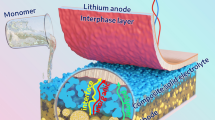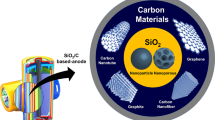Abstract
Tin selenides have been attracting great attention as anode materials for the state-of-the-art rechargeable sodium-ion batteries (SIBs) due to their high theoretical capacity and low cost. However, they deliver unsatisfactory performance in practice, owing to their intrinsically low conductivity, sluggish kinetics and volume expansion during the charge-discharge process. Herein, we demonstrate the synthesis of SnSe2 nanocrystals coupled with hierarchical porous carbon (SnSe2 NCs/C) microspheres for boosting SIBs in terms of capacity, rate ability and durability. The unique structure of SnSe2 NCs/C possesses several advantages, including inhibiting the agglomeration of SnSe2 nanoparticles, relieving the volume expansion, accelerating the diffusion kinetics of electrons/ions, enhancing the contact area between the electrode and electrolyte and improving the structural stability of the composite. As a result, the as-obtained SnSe2 NCs/C microspheres show a high reversible capacity (565 mA h g−1 after 100 cycles at 100 mA g−1), excellent rate capability, and long cycling life stability (363 mA h g−1 at 1 A g−1 after 1000 cycles), which represent the best performances among the reported SIBs based on SnSe2-based anode materials.
摘要
硒化锡用于钠离子电池负极时具有较高的理论比容量且其 成本低廉, 因而备受关注. 然而, 由于其固有的低导电性, 以及在充 放电过程中的缓慢动力学和体积膨胀, 硒化锡作为钠离子电池负 极材料表现出的性能较差. 本文首次合成SnSe2纳米晶耦合分层多 孔碳微球(SnSe2 NCs/C)用于增强钠离子电池的比容量、倍率能力 和持久性. SnSe2 NCs/C独特的结构可以有效阻止SnSe2纳米晶的团 聚, 减轻材料体积膨胀, 加快电子和离子的扩散, 增大电解液与电极 材料的接触面积, 提高材料结构的稳定性. 所制备的SnSe2 NCs/C微 球具有较高的可逆比容量(在100 mA g−1的电流密度下循环100圈 后仍保持565 mA h g−1的比容量), 出色的倍率能力和长循环寿命稳 定性(在1 A g−1的电流密度下循环1000圈后仍保持363 mA h g−1的 比容量).
Similar content being viewed by others
References
Dunn B, Kamath H, Tarascon JM. Electrical energy storage for the grid: A battery of choices. Science, 2011, 334: 928–935
Shen L, Yu Y. Greener and cheaper. Nat Energy, 2017, 2: 836–837
Larcher D, Tarascon JM. Towards greener and more sustainable batteries for electrical energy storage. Nat Chem, 2015, 7: 19–29
Luo W, Shen F, Bommier C, et al. Na-ion battery anodes: Materials and electrochemistry. Acc Chem Res, 2016, 49: 231–240
Firouzi A, Qiao R, Motallebi S, et al. Monovalent manganese based anodes and co-solvent electrolyte for stable low-cost high-rate sodium-ion batteries. Nat Commun, 2018, 9: 861
Xiang X, Zhang K, Chen J. Recent advances and prospects of cathode materials for sodium-ion batteries. Adv Mater, 2015, 27: 5343–5364
Yu L, Wang LP, Liao H, et al. Understanding fundamentals and reaction mechanisms of electrode materials for Na-ion batteries. Small, 2018, 14: 1703338
Li Z, Bommier C, Chong ZS, et al. Mechanism of Na-ion storage in hard carbon anodes revealed by heteroatom doping. Adv Energy Mater, 2017, 7: 1602894
Park H, Kwon J, Choi H, et al. Microstructural control of new intercalation layered titanoniobates with large and reversible dspacing for easy Na+ ion uptake. Sci Adv, 2017, 3: e1700509
Wu T, Jing M, Yang L, et al. Controllable chain-length for covalent sulfur-carbon materials enabling stable and high-capacity sodium storage. Adv Energy Mater, 2019, 9: 1803478
Fang Y, Liu Q, Xiao L, et al. A fully sodiated NaVOPO4 with layered structure for high-voltage and long-lifespan sodium-ion batteries. Chem, 2018, 4: 1167–1180
Wang S, Xia L, Yu L, et al. Free-standing nitrogen-doped carbon nanofiber films: integrated electrodes for sodium-ion batteries with ultralong cycle life and superior rate capability. Adv Energy Mater, 2016, 6: 1502217
Li Y, Mu L, Hu YS, et al. Pitch-derived amorphous carbon as high performance anode for sodium-ion batteries. Energy Storage Mater, 2016, 2: 139–145
Pan H, Hu YS, Chen L. Room-temperature stationary sodium-ion batteries for large-scale electric energy storage. Energy Environ Sci, 2013, 6: 2338
Nie Z, Fava D, Kumacheva E, et al. Self-assembly of metal-polymer analogues of amphiphilic triblock copolymers. Nat Mater, 2007, 6: 609–614
Ma D, Li Y, Mi H, et al. Robust SnO2−x nanoparticle-impregnated carbon nanofibers with outstanding electrochemical performance for advanced sodium-ion batteries. Angew Chem Int Ed, 2018, 57: 8901–8905
Miao C, Liu M, He YB, et al. Monodispersed SnO2 nanospheres embedded in framework of graphene and porous carbon as anode for lithium ion batteries. Energy Storage Mater, 2016, 3: 98–105
Zhao K, Zhang L, Xia R, et al. SnO2 quantum dots@graphene oxide as a high-rate and long-life anode material for lithium-ion batteries. Small, 2016, 12: 588–594
Liang J, Yu XY, Zhou H, et al. Bowl-like SnO2@carbon hollow particles as an advanced anode material for lithium-ion batteries. Angew Chem Int Ed, 2014, 53: 12803–12807
Xiong X, Yang C, Wang G, et al. SnS nanoparticles electrostatically anchored on three-dimensional N-doped graphene as an active and durable anode for sodium-ion batteries. Energy Environ Sci, 2017, 10: 1757–1763
He P, Fang Y, Yu XY, et al. Hierarchical nanotubes constructed by carbon-coated ultrathin SnS nanosheets for fast capacitive sodium storage. Angew Chem Int Ed, 2017, 56: 12202–12205
Liu Y, Yu XY, Fang Y, et al. Confining SnS2 ultrathin nanosheets in hollow carbon nanostructures for efficient capacitive sodium storage. Joule, 2018, 2: 725–735
Luo B, Fang Y, Wang B, et al. Two dimensional graphene-SnS2 hybrids with superior rate capability for lithium ion storage. Energy Environ Sci, 2012, 5: 5226–5230
Jiang Y, Wei M, Feng J, et al. Enhancing the cycling stability of Naion batteries by bonding SnS2 ultrafine nanocrystals on aminofunctionalized graphene hybrid nanosheets. Energy Environ Sci, 2016, 9: 1430–1438
Xu Y, Peng B, Mulder FM. A high-rate and ultrastable sodium ion anode based on a novel Sn4P3-P@graphene nanocomposite. Adv Energy Mater, 2018, 8: 1701847
Li Q, Li Z, Zhang Z, et al. Low-temperature solution-based phosphorization reaction route to Sn4P3/reduced graphene oxide nanohybrids as anodes for sodium ion batteries. Adv Energy Mater, 2016, 6: 1600376
Wang W, Li P, Zheng H, et al. Ultrathin layered snse nanoplates for low voltage, high-rate, and long-life alkali-ion batteries. Small, 2017, 13: 1702228
Yuan S, Zhu YH, Li W, et al. Surfactant-free aqueous synthesis of pure single-crystalline SnSe nanosheet clusters as anode for high energy- and power-density sodium-ion batteries. Adv Mater, 2017, 29: 1602469
Zhang F, Xia C, Zhu J, et al. SnSe2 2D anodes for advanced sodium ion batteries. Adv Energy Mater, 2016, 6: 1601188
Choi J, Jin J, Jung IG, et al. SnSe2 nanoplate-graphene composites as anode materials for lithium ion batteries. Chem Commun, 2011, 47: 5241–5243
Wei Z, Wang L, Zhuo M, et al. Layered tin sulfide and selenide anode materials for Li- and Na-ion batteries. J Mater Chem A, 2018, 6: 12185–12214
Xiang Huang Z, Liu B, Kong D, et al. SnSe2 quantum dot/rGO composite as high performing lithium anode. Energy Storage Mater, 2018, 10: 92–101
Sun W, Rui X, Yang D, et al. Two-dimensional tin disulfide nanosheets for enhanced sodium storage. ACS Nano, 2015, 9: 11371–11381
Yao J, Liu B, Ozden S, et al. 3D nanostructured molybdenum diselenide/graphene foam as anodes for long-cycle life lithium-ion batteries. Electrochim Acta, 2015, 176: 103–111
Qu B, Ma C, Ji G, et al. Layered SnS2-reduced graphene oxide composite-a high-capacity, high-rate, and long-cycle life sodiumion battery anode material. Adv Mater, 2014, 26: 3854–3859
Jiang X, Yang X, Zhu Y, et al. In situ assembly of graphene sheetssupported SnS2 nanoplates into 3D macroporous aerogels for highperformance lithium ion batteries. J Power Sources, 2013, 237: 178–186
Ko YN, Choi SH, Park SB, et al. Hierarchical MoSe2 yolk-shell microspheres with superior Na-ion storage properties. Nanoscale, 2014, 6: 10511–10515
Zhou X, Wan LJ, Guo YG. Binding SnO2 nanocrystals in nitrogendoped graphene sheets as anode materials for lithium-ion batteries. Adv Mater, 2013, 25: 2152–2157
Zhai C, Du N, Zhang H, et al. Multiwalled carbon nanotubes anchored with SnS2 nanosheets as high-performance anode materials of lithium-ion batteries. ACS Appl Mater Interfaces, 2011, 3: 4067–4074
Yang C, Feng J, Lv F, et al. Metallic graphene-like VSe2 ultrathin nanosheets: superior potassium-ion storage and their working mechanism. Adv Mater, 2018, 30: 1800036
Wang W, Jiang B, Qian C, et al. Pistachio-shuck-like MoSe2/C core/shell nanostructures for high-performance potassium-ion storage. Adv Mater, 2018, 30: 1801812
Xiao Y, Su D, Wang X, et al. CuS microspheres with tunable interlayer space and micropore as a high-rate and long-life anode for sodium-ion batteries. Adv Energy Mater, 2018, 8: 1800930
Fang G, Wang Q, Zhou J, et al. Metal organic framework-templated synthesis of bimetallic selenides with rich phase boundaries for sodium-ion storage and oxygen evolution reaction. ACS Nano, 2019, 13: 5635–5645
Cai Y, Cao X, Luo Z, et al. Caging Na3V2(PO4)2F3 microcubes in cross-linked graphene enabling ultrafast sodium storage and longterm cycling. Adv Sci, 2018, 5: 1800680
Feng Y, Chen S, Wang J, et al. Carbon foam with microporous structure for high performance symmetric potassium dual-ion capacitor. J Energy Chem, 2020, 43: 129–138
Liu X, Zhao L, Wang S, et al. Hierarchical-structure anatase TiO2 with conductive network for high-rate and high-loading lithiumion battery. Sci Bull, 2019, 64: 1148–1151
Liu R, Liang Z, Gong Z, et al. Research progress in multielectron reactions in polyanionic materials for sodium-ion batteries. Small Methods, 2018, 3: 1800221
Wang WA, Huang H, Wang B, et al. A new dual-ion battery based on amorphous carbon. Sci Bull, 2019, 64: 1634–1642
Hao J, Peng S, Qin T, et al. Fabrication of hybrid Co3O4/NiCo2O4 nanosheets sandwiched by nanoneedles for high-performance supercapacitors using a novel electrochemical ion exchange. Sci China Mater, 2017, 60: 1168–1178
Guo S, Sun Y, Liu P, et al. Cation-mixing stabilized layered oxide cathodes for sodium-ion batteries. Sci Bull, 2018, 63: 376–384
Xu ZL, Park J, Yoon G, et al. Graphitic carbon materials for advanced sodium-ion batteries. Small Methods, 2018, 3: 1800227
Jiang H, Zhao T, Ren Y, et al. Ab initio prediction and characterization of phosphorene-like SiS and SiSe as anode materials for sodium-ion batteries. Sci Bull, 2017, 62: 572–578
Li M, Yang W, Huang Y, et al. Hierarchical mesoporous Co3O4@ ZnCo2O4 hybrid nanowire arrays supported on Ni foam for highperformance asymmetric supercapacitors. Sci China Mater, 2018, 61: 1167–1176
Acknowledgements
This work was supported by the National Key R&D Research Program of China (2016YFB0100201), Beijing Natural Science Foundation (JQ18005), the National Natural Science Foundation of China (51671003, 21802003), China Postdoctoral Science Foundation (2019TQ0001), and the start-up supports from Peking University and Young Thousand Talented Program.
Author information
Authors and Affiliations
Contributions
Guo S conceived the project and directed the experiment. Chen H designed the experiments. Chen H, Mu Z and Li Y prepared and carried out the main experiments and characterization. Chen H wrote the manuscript. All authors contributed to the data analysis, discussed the results, and commented on the manuscript.
Corresponding author
Additional information
Conflict of interest
The authors declare no conflict of interest.
Supplementary information Experimental details and supporting data are available in the online version of the paper.
Hui Chen is a PhD student of the University of Electronic Science and Technology of China under the supervision of Prof. Jinshu Wang. Currently, he is studying at Peking University as an exchange student in Prof. Shaojun Guo’s group. His research interests include the synthesis and characterization of nanomaterials for alkali-ion batteries, photocatalysis and perovskite solar cells.
Shaojun Guo received his BSc degree in Jilin University (2005) and PhD degree in the Chinese Academy of Sciences (2010). He worked as a postdoctoral researcher associate at Brown University (2011-2013) and as a prestigious Oppenheimer Distinguished Fellow at Los Alamos National Laboratory (2013-2015). He joined the College of Engineering, Peking University in 2015 and is currently a Professor. His research interests focus on engineering nanocrystals and 2D materials for catalysis, renewable energy, optoelectronics and biosensors.
Electronic supplementary material
Rights and permissions
About this article
Cite this article
Chen, H., Mu, Z., Li, Y. et al. SnSe2 nanocrystals coupled with hierarchical porous carbon microspheres for long-life sodium ion battery anode. Sci. China Mater. 63, 483–491 (2020). https://doi.org/10.1007/s40843-019-1229-0
Received:
Accepted:
Published:
Issue Date:
DOI: https://doi.org/10.1007/s40843-019-1229-0




